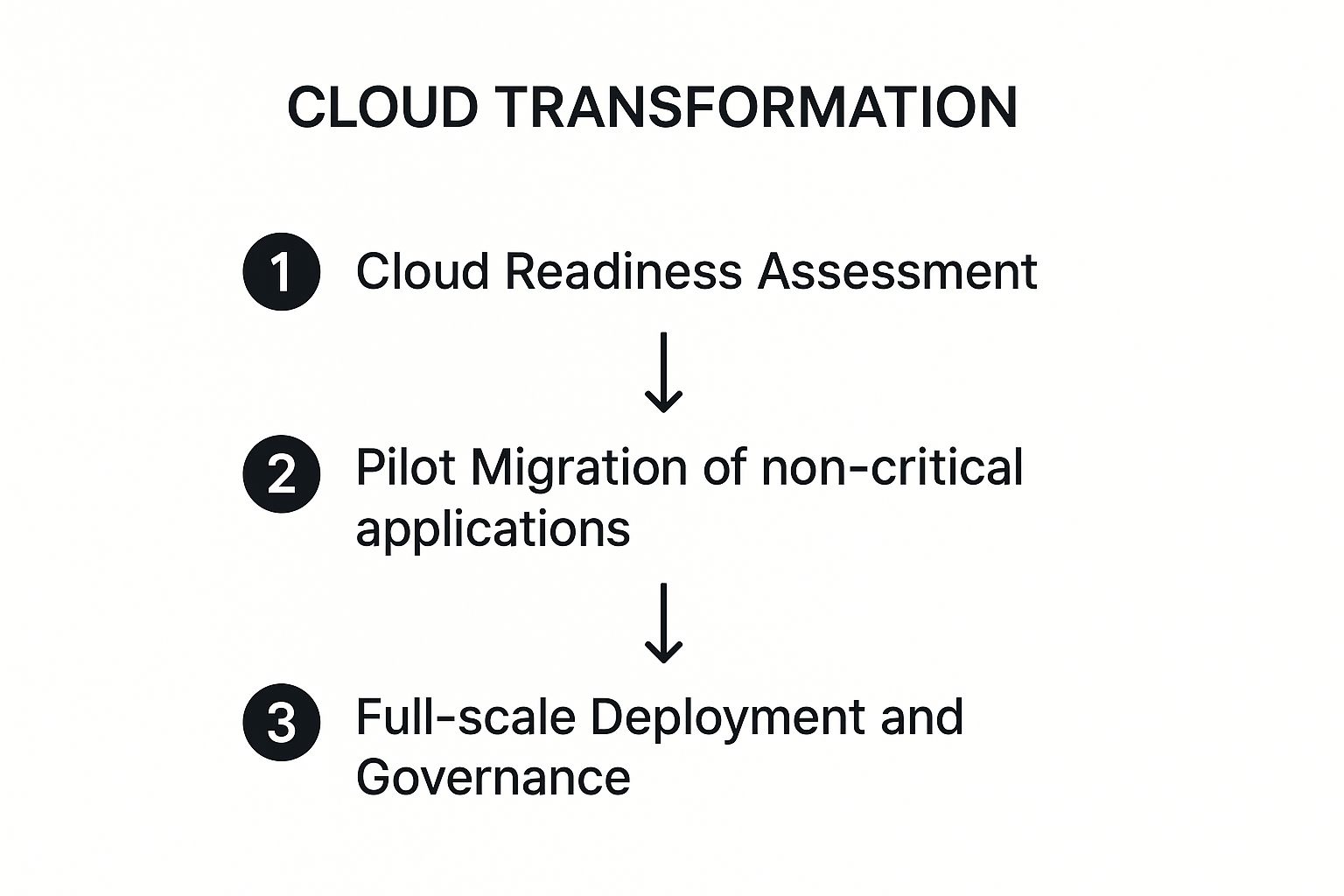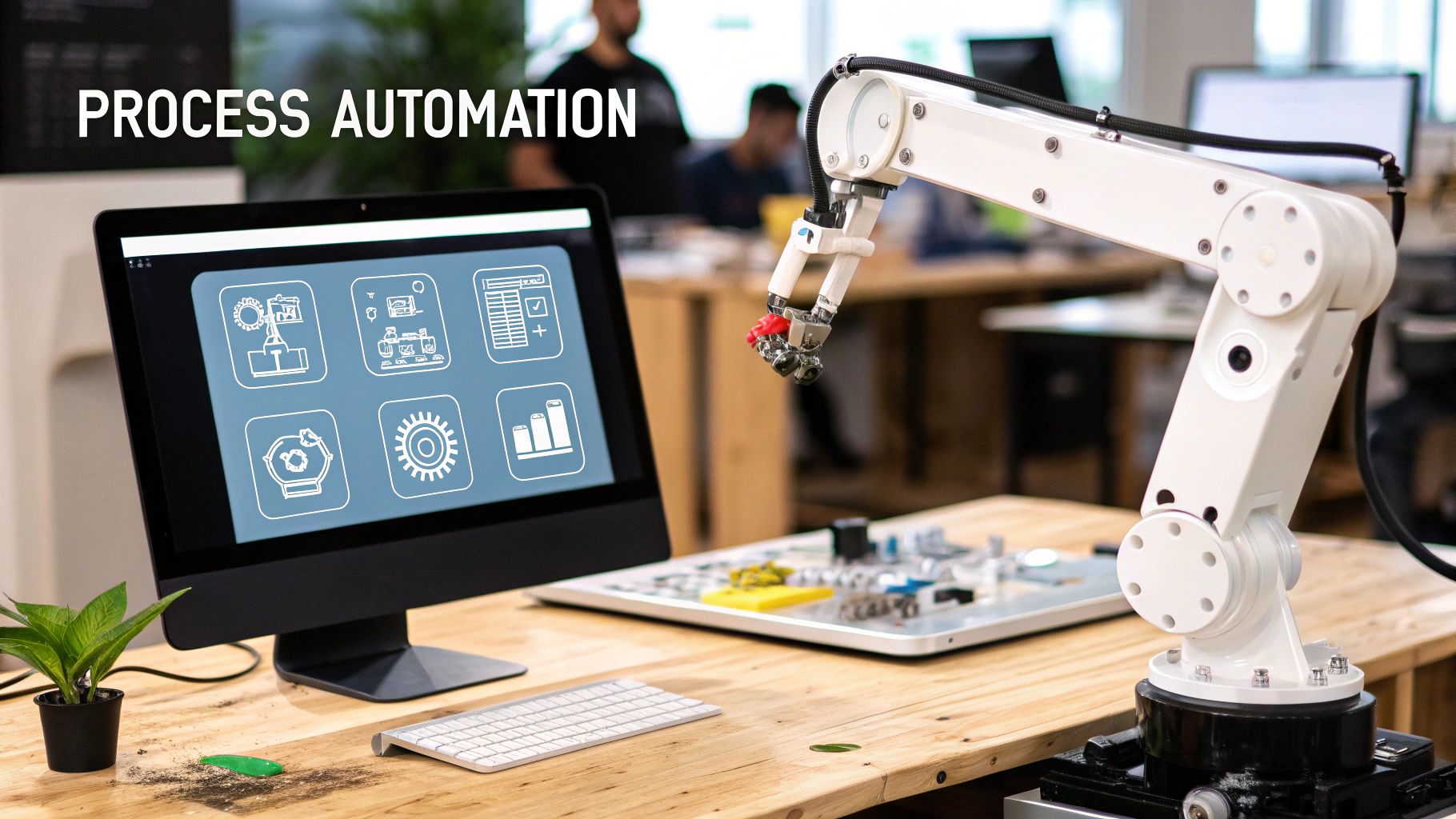Unlocking Growth: The Blueprint Behind Today's Top Digital Transformations
In a business environment where digital disruption is the new norm, a well-defined strategy is no longer optional-it's essential for survival and growth. But what does a successful digital transformation look like in practice? Moving beyond theory, this article delves into tangible digital transformation strategy examples from industry leaders who have successfully navigated this complex journey. We break down eight powerful strategies, from revolutionising the customer experience with AI to building resilient, cloud-first infrastructures.
This is not a high-level overview. For each example, we will explore the specific tactics, analyse the outcomes, and extract actionable lessons you can apply to your own organisation. Understanding the core principles behind these moves is critical. To fully understand the landscape and enhance your initiatives, explore these proven digital transformation best practices.
Our analysis focuses on the 'how' and 'why' behind each initiative, offering a strategic blueprint for driving meaningful change. Prepare to gain insights into achieving a sustainable competitive advantage in 2025 and beyond by examining real-world applications of the following key transformation areas:
- Customer-Centric Digital Experience
- Data-Driven Decision Making
- Cloud-First Infrastructure
- AI-Powered Process Optimisation
- Agile and DevOps Methodologies
- Digital Product and Service Innovation
- Supply Chain and Operations Digitalisation
- Digital Workplace and Remote Collaboration
1. Customer-Centric Digital Experience Transformation
This foundational digital transformation strategy example reorients the entire organisation around the customer. It moves beyond simple service improvements to fundamentally redesign every customer touchpoint using digital technologies. The goal is to create seamless, personalised, and intuitive experiences across all channels, from initial awareness to post-purchase support. This involves deeply understanding customer behaviour through data analytics and using technologies like AI and omnichannel platforms to deliver tailored interactions at every stage of the journey.

This approach is powerful because it directly impacts customer loyalty, retention, and lifetime value. By prioritising the customer experience, companies can build strong emotional connections and create significant competitive differentiation. Success stories like Starbucks' mobile app, which combines seamless ordering with a personalised loyalty programme, and Disney's MagicBand system, which integrates park access, payments, and photo services into a single device, showcase the immense potential of this strategy.
Strategic Breakdown and Actionable Insights
To implement this transformation, organisations must adopt a multi-faceted approach. A prime example of this is Sony's Nuro Hikari revolutionizing customer support with Docsbot's AI-powered chatbot, demonstrating tangible benefits in operational efficiency and customer satisfaction by providing instant, 24/7 support.
Key tactics include:
- Comprehensive Customer Journey Mapping: Visualise every interaction a customer has with your brand to identify pain points and opportunities for digital enhancement.
- Invest in a Customer Data Platform (CDP): A robust CDP is crucial for unifying customer data from various sources (e.g., website, mobile app, CRM, in-store) to create a single, coherent customer view.
- Prioritise Mobile-First Design: With a majority of digital interactions occurring on mobile devices, optimising the mobile experience is non-negotiable for a successful customer-centric strategy.
- Foster Cross-Functional Collaboration: Silos are the enemy of a seamless customer experience. Teams from marketing, sales, product development, and customer support must work together towards a unified goal.
- Iterate and Optimise: Launch pilot programmes to test new digital experiences with smaller segments. Use A/B testing and user feedback to continuously refine and improve interactions.
2. Data-Driven Decision Making and Analytics Transformation
This digital transformation strategy example focuses on embedding data at the core of every business operation. It moves organisations from relying on intuition or historical reporting to leveraging advanced analytics, artificial intelligence, and real-time data streams for predictive insights and automated decision-making. The objective is to build a robust data infrastructure and cultivate a data-literate culture, empowering teams across all functions to make faster, more accurate, and forward-looking decisions that drive efficiency and growth.
This strategy is critical for gaining a competitive edge in today's market. By transforming raw data into actionable intelligence, companies can optimise supply chains, personalise marketing, anticipate customer needs, and uncover new revenue opportunities. For instance, UPS’s ORION (On-Road Integrated Optimisation and Navigation) system uses advanced algorithms and vehicle telematics data to optimise delivery routes in real-time, saving millions in fuel and operating costs. Similarly, Netflix’s use of viewing data to inform content acquisition and production decisions demonstrates the power of analytics in shaping product strategy.
Strategic Breakdown and Actionable Insights
To effectively transition into a data-driven organisation, businesses must build both technological capabilities and human expertise. This requires a coordinated effort to democratise data access while ensuring its quality and security. A notable case is American Express, which utilises sophisticated AI and machine learning models to analyse billions of transactions, allowing it to detect and prevent fraudulent activity with incredible speed and accuracy, protecting both customers and the company.
Key tactics include:
- Establish Clear Data Governance: Create and enforce policies for data quality, accessibility, security, and privacy to build a trusted data foundation.
- Invest in Data Literacy: Equip employees at all levels with the skills and tools needed to understand, interpret, and communicate with data effectively through ongoing training programmes.
- Choose Scalable Analytics Platforms: Adopt cloud-based platforms that can handle large volumes of data and provide a flexible suite of tools for business intelligence, data science, and machine learning.
- Start with High-Impact Use Cases: Begin with projects that solve a specific, high-value business problem, like supply chain optimisation or customer churn prediction, to demonstrate ROI and build momentum.
- Create Cross-Functional Data Teams: Assemble teams with a mix of skills, including data engineers, analysts, and business domain experts, to ensure that analytics initiatives are aligned with strategic objectives.
3. Cloud-First Infrastructure and Platform Transformation
This pivotal digital transformation strategy example involves migrating an organisation's core infrastructure, applications, and services to cloud-based platforms. It shifts the focus from managing on-premise hardware to leveraging the scalability, flexibility, and efficiency of cloud providers like AWS, Microsoft Azure, and Google Cloud. The strategy goes beyond a simple "lift-and-shift" of existing systems; it encourages the adoption of cloud-native architectures, such as microservices and containerisation, to build more resilient, agile, and globally accessible business solutions.
This approach is powerful because it fundamentally changes how a company operates, enabling rapid innovation, significant cost optimisation, and enhanced operational resilience. It allows businesses to scale resources up or down on demand, paying only for what they use, and frees up IT teams to focus on value-creating activities instead of server maintenance. Success stories like Capital One's complete migration to AWS, which enabled them to innovate like a tech company, and Netflix's cloud-native architecture, which supports its massive global streaming service, highlight the transformative potential of a cloud-first mindset.
Strategic Breakdown and Actionable Insights
To successfully execute this transformation, organisations must follow a structured and strategic path. The process flow infographic below illustrates a proven, three-step methodology for a disciplined cloud migration.

This visualised approach emphasises a phased rollout, starting with a thorough assessment to ensure readiness, followed by a controlled pilot to mitigate risk, and concluding with a full-scale deployment governed by clear policies. For organisations looking to leverage specific platforms, understanding the ecosystem is key; learn more about the strategic benefits of Azure cloud services in the UAE for tailored insights.
Key tactics include:
- Conduct a Thorough Cloud Readiness Assessment: Evaluate your existing applications, infrastructure, and team skill sets to identify gaps and create a detailed migration roadmap.
- Start with Non-Critical Applications: Begin the migration process with lower-risk applications to build experience, test processes, and demonstrate early wins before tackling core systems.
- Implement Robust Cloud Governance: Establish clear policies for cost management, security, and compliance from the outset. Use tools to monitor spending and enforce security protocols automatically.
- Invest in Team Training: Upskill your IT teams on cloud-native technologies, DevOps practices, and platform-specific certifications to ensure they can effectively manage the new environment.
- Prioritise Automation: Use Infrastructure as Code (IaC) and CI/CD pipelines to automate the deployment, scaling, and management of cloud resources, reducing manual errors and increasing efficiency.
4. Automation and AI-Powered Process Optimisation
This strategy leverages robotic process automation (RPA), artificial intelligence, and machine learning to fundamentally re-engineer internal operations. The core objective is to automate repetitive, manual tasks, thereby optimising entire business processes for greater efficiency and accuracy. This digital transformation strategy example focuses on identifying and digitising workflows to reduce operational costs, minimise human error, and crucially, reallocate employee talent towards more strategic, high-value activities that require creativity and critical thinking.

The power of this approach lies in its ability to drive significant internal improvements that ripple outwards to the customer experience. By streamlining backend operations, organisations can deliver faster, more reliable services. For instance, Siemens uses AI for predictive maintenance on manufacturing equipment to prevent downtime, while JPMorgan Chase’s COIN system rapidly analyses legal contracts, a task that previously consumed thousands of human hours. These examples showcase how automation can create a leaner, more agile, and resilient organisation.
Strategic Breakdown and Actionable Insights
Successful implementation requires a deliberate and phased approach, moving from simple tasks to more complex, AI-driven processes. Understanding the full scope of business process automation benefits is key to gaining organisational buy-in and building momentum.
Key tactics include:
- Start with High-Volume, Rule-Based Processes: Identify tasks that are frequent, time-consuming, and follow a clear set of rules, such as data entry or invoice processing. These are ideal candidates for initial RPA implementation and quick wins.
- Conduct Thorough Process Mapping: Before automating, meticulously map the existing workflow to identify inefficiencies, bottlenecks, and dependencies. This ensures the automated process is optimised from the start.
- Implement Comprehensive Change Management: Automation can impact employee roles. A proactive change management programme is essential to communicate benefits, provide reskilling opportunities, and manage the transition smoothly.
- Choose Scalable Automation Platforms: Select technology, like solutions from UiPath or Microsoft's Power Platform, that can grow with your organisation's needs, moving from simple RPA to more sophisticated AI-powered automation.
- Maintain Human Oversight: For critical decision-making processes, implement a "human-in-the-loop" system. This ensures that while automation handles the heavy lifting, human judgement is retained for final approval and complex exceptions.
5. Agile and DevOps Organisational Transformation
This digital transformation strategy example focuses on a deep cultural and operational shift towards speed, collaboration, and continuous improvement. It involves adopting Agile methodologies and DevOps practices to fundamentally change how an organisation builds and delivers products and services. The core objective is to break down the traditional silos between development (Dev) and operations (Ops) teams, fostering a unified culture of shared responsibility. This approach leverages automation, iterative development, and rapid feedback loops to enhance deployment frequency, quality, and overall business responsiveness.
This transformation is powerful because it directly enables the business to innovate and adapt at market speed. By creating a high-velocity delivery pipeline, companies can release new features faster, respond to customer feedback more effectively, and reduce the risk associated with large-scale deployments. Pioneering examples include Spotify’s autonomous "squad" model and ING Bank's complete reorganisation into Agile "tribes," which have demonstrated how this strategy can drastically improve time-to-market and employee engagement.
Strategic Breakdown and Actionable Insights
To succeed with this transformation, organisations must commit to more than just new tools; they must champion a new mindset. A key aspect of this in today's landscape is implementing effective strategies for distributed Agile teams to ensure seamless development and delivery, regardless of physical location. This focus on both culture and practice is essential for realising the full benefits of speed and quality.
Key tactics include:
- Foster a Culture of Psychological Safety: Teams must feel safe to experiment, fail, and learn without blame. This is the bedrock of a true Agile and DevOps environment.
- Invest in a Comprehensive Toolchain: Implement tools for continuous integration/continuous deployment (CI/CD), automated testing, and infrastructure as code (IaC) to automate the entire delivery pipeline.
- Start with Pilot Teams: Identify a value-driven project and a motivated team to pilot the new ways of working. Use their successes and lessons learned to scale the transformation across the organisation.
- Prioritise Training and Coaching: Provide extensive training on Agile principles (like Scrum or Kanban) and DevOps practices. Embed experienced coaches within teams to guide the transition and reinforce new behaviours.
- Measure What Matters: Shift from traditional project metrics to DevOps-focused metrics like deployment frequency, lead time for changes, mean time to recovery (MTTR), and change failure rate.
6. Digital Product and Service Innovation Strategy
This digital transformation strategy example centres on creating entirely new digital products, services, or even business models. It shifts the focus from optimising existing operations to inventing novel revenue streams and value propositions powered by technology. The core idea is to leverage emerging technologies like IoT, AI, and blockchain to address unmet customer needs or disrupt established markets. This requires building dedicated innovation capabilities, fostering a culture of experimentation, and embracing risk to develop breakthrough offerings.
This strategy is transformative because it can fundamentally alter a company's market position and growth trajectory. By innovating at the product level, organisations can create new markets, as Apple did with the App Store, or redefine existing ones, like Tesla's over-the-air software updates that continuously improve vehicle functionality post-purchase. Success stories like John Deere’s move into precision agriculture with IoT-enabled equipment showcase how even traditional industrial companies can become tech leaders through this approach.
Strategic Breakdown and Actionable Insights
To successfully execute this strategy, organisations must create an environment where new ideas can be systematically developed, tested, and scaled. This involves a deliberate investment in both people and processes dedicated to exploring the technological frontier.
Key tactics include:
- Establish Dedicated Innovation Teams: Create ring-fenced teams or "digital labs" with their own budgets and mandates to explore new technologies and business models without the constraints of daily operations.
- Utilise Design Thinking Methodology: Employ customer-centric methodologies like design thinking to deeply understand user problems and co-create solutions, ensuring new products have a strong market fit.
- Foster a "Safe-to-Fail" Environment: Encourage experimentation by creating a culture where failure is viewed as a learning opportunity. This is critical for pursuing bold ideas that carry inherent risk.
- Partner with Start-ups and Tech Providers: Accelerate innovation by collaborating with agile start-ups and specialised technology partners to gain access to cutting-edge expertise and solutions.
- Focus on Solving Real Customer Problems: Ground all innovation efforts in a clear understanding of a genuine customer pain point. The most successful digital products are not just technologically advanced; they provide tangible value and solve real-world issues.
7. Supply Chain and Operations Digitalisation
This digital transformation strategy example targets the core operational backbone of a business: its supply chain. It involves a fundamental overhaul of how goods are sourced, managed, and delivered by embedding digital technologies throughout the entire process. Utilising tools like IoT sensors for real-time tracking, AI for demand forecasting, and blockchain for secure transaction logging, companies create an intelligent, connected, and resilient supply network. The ultimate goal is to achieve end-to-end visibility, enabling proactive disruption management, optimised inventory levels, and enhanced efficiency from the first supplier to the final customer.
This approach is critical in today's volatile global market, where supply chain disruptions can cripple an organisation. By digitalising operations, companies gain the agility to respond to market shifts in real-time, reduce waste, and improve delivery reliability. Prime examples include Walmart's extensive use of technology for an end-to-end visibility platform and DHL’s deployment of IoT and predictive analytics to optimise logistics. These initiatives demonstrate how digitalisation transforms the supply chain from a mere cost centre into a powerful strategic advantage and a key differentiator.
Strategic Breakdown and Actionable Insights
To effectively digitalise the supply chain, organisations must orchestrate a coordinated effort across technology, processes, and partnerships. This involves moving beyond siloed functions to create an integrated ecosystem where data flows freely and securely between all stakeholders.
Key tactics include:
- Start with High-Impact Pilot Projects: Identify a specific area of the supply chain with significant pain points, such as warehouse management or last-mile delivery, and launch a focused pilot project to demonstrate value and build momentum.
- Ensure Strong Supplier Partnership and Collaboration: A digital supply chain is only as strong as its weakest link. Work closely with key suppliers to ensure they can integrate with your new digital platforms and share data effectively.
- Invest in Data Integration and Analytics Capabilities: The foundation of a digital supply chain is data. Invest in platforms that can unify data from disparate systems (ERP, WMS, TMS) and apply advanced analytics to generate actionable insights.
- Implement Robust Cybersecurity Measures: As you connect more systems and share more data, the risk of cyber threats increases. Prioritise a robust cybersecurity framework to protect sensitive operational and commercial information.
- Focus on Interoperability and Standardisation: Use technologies and build systems based on open standards to avoid vendor lock-in and ensure seamless communication between different parts of your supply chain ecosystem.
8. Digital Workplace and Remote Collaboration Transformation
This strategic transformation reimagines the traditional office by creating a fully digital, cloud-based workplace environment. It enables seamless remote and hybrid work experiences through the comprehensive implementation of collaboration platforms, digital communication tools, virtual meeting solutions, and mobile-first applications. The objective is to empower employees to work effectively from anywhere while sustaining productivity, engagement, and a strong company culture, making it one of the most relevant digital transformation strategy examples in the modern era.

This approach is powerful as it directly addresses the evolving expectations of the global workforce for flexibility and work-life balance. By investing in a digital workplace, companies can attract and retain top talent, reduce operational costs associated with physical offices, and build a more resilient and agile organisation. Leading examples include GitLab's pioneering fully remote model, Shopify's pivot to a digital-first workplace, and Microsoft's own extensive use of its Teams platform to facilitate global collaboration. The power of integrated platforms like Microsoft Teams showcases how to effectively unify communication and workflows.
Strategic Breakdown and Actionable Insights
To successfully execute a digital workplace transformation, organisations need to go beyond simply providing laptops and software. It requires a cultural shift supported by a robust technological foundation and clear governance. An excellent illustration is Siemens' global initiative to establish a permanent mobile working model for a significant portion of its workforce, focusing on leadership style and results-oriented management.
Key tactics include:
- Establish Clear Remote Work Policies: Develop comprehensive guidelines covering communication expectations, working hours, data security, and performance metrics to ensure clarity and consistency.
- Invest in Comprehensive Employee Training: Equip your team with the skills to effectively use new digital tools and platforms, focusing on best practices for virtual collaboration and communication.
- Prioritise Robust Security Measures: Implement multi-factor authentication, VPNs, and endpoint security to protect company data and ensure compliance, regardless of where employees are working from.
- Focus on Results-Oriented Performance: Shift performance management from tracking hours to evaluating outcomes and impact, fostering a culture of trust and autonomy.
- Create Virtual Engagement Activities: Proactively organise virtual team-building events, informal social channels, and digital "water cooler" moments to maintain team cohesion and combat isolation.
Digital Transformation Strategy Comparison Table
| Transformation Type | Implementation Complexity 🔄 | Resource Requirements ⚡ | Expected Outcomes 📊 | Ideal Use Cases 💡 | Key Advantages ⭐ |
|---|---|---|---|---|---|
| Customer-Centric Digital Experience Transformation | High: requires complex system integration & organizational change | High: investment in AI, CDP, omnichannel platforms | Increased customer satisfaction, loyalty, and revenue growth | Enhancing multi-channel customer experience and personalization | Superior customer insights, loyalty, and competitive edge |
| Data-Driven Decision Making and Analytics Transformation | High: involves complex data infrastructure, governance, and skills | High: investment in data platforms, analytics tools | Faster, accurate decisions; improved operational efficiency | Organizations aiming to leverage data for business decisions | Enhanced decision accuracy and market competitiveness |
| Cloud-First Infrastructure and Platform Transformation | Medium-High: cloud migration & architecture redesign complexity | Medium-High: cloud platforms, DevOps tools, skill training | Scalability, flexibility, cost optimization, faster deployments | Enterprises migrating to cloud-native infrastructure | Cost savings, scalability, resilience, and faster innovation |
| Automation and AI-Powered Process Optimization | Medium: requires process analysis & integration with legacy systems | Medium: RPA tools, AI platforms, change management resources | Reduced costs, improved accuracy, 24/7 operations | Automating repetitive tasks and optimizing workflows | Significant efficiency gains and error reduction |
| Agile and DevOps Organizational Transformation | Medium-High: cultural change and new practices adoption | Medium: training, tooling, leadership commitment | Faster delivery, improved software quality, better collaboration | Software development and IT operations improvement | Accelerated time-to-market with high product quality |
| Digital Product and Service Innovation Strategy | High: requires R&D investment, innovative culture, and risk-taking | High: specialized talent, innovation labs, tech adoption | New revenue streams, market disruption, enhanced engagement | Developing breakthrough digital products & business models | Competitive differentiation and future-proofing |
| Supply Chain and Operations Digitalization | High: complex integration of IoT, blockchain, AI across supply chain | High: IoT devices, blockchain platform, data analytics | Improved transparency, reduced costs, enhanced risk management | Optimizing and digitizing comprehensive supply chains | End-to-end visibility and operational efficiency |
| Digital Workplace and Remote Collaboration Transformation | Medium: tool deployment & cultural adaptation | Medium: cloud collaboration platforms, training | Increased flexibility, productivity, and business continuity | Remote/hybrid workforce enablement | Enhanced employee satisfaction and operational resilience |
From Strategy to Execution: Your Next Steps in Digital Transformation
The digital transformation strategy examples we have explored reveal a powerful, unifying theme: success is not about adopting technology for technology's sake. It is about strategically realigning your organisation’s people, processes, and platforms around a singular, customer-centric vision. True transformation is a deliberate, orchestrated effort that reimagines how value is created and delivered in a digital-first world.
From revolutionising the customer experience and embedding data into every decision, to optimising operations with AI and fostering an agile culture, these case studies demonstrate that lasting change is multifaceted. Each initiative, whether focused on supply chain digitalisation or building a digital-native workplace, underscores the necessity of a clear strategy that is championed by leadership and embraced by the entire organisation. The common thread is the move away from siloed functions towards an integrated, responsive, and resilient enterprise.
Core Takeaways for Your Transformation Journey
Reflecting on these diverse digital transformation strategy examples, several key principles stand out as critical for success:
- Customer-Centricity is Non-Negotiable: Every successful strategy ultimately serves the customer better. Whether through personalised services, seamless interactions, or faster delivery, the end-user experience must be the central focus of your efforts.
- Data is Your Most Valuable Asset: Organisations that harness data for predictive insights, operational efficiency, and strategic planning gain a significant competitive advantage. Building a robust data analytics capability is fundamental to modern business.
- Agility Drives Adaptation: The market landscape is in constant flux. An agile organisational structure, coupled with a DevOps mindset, allows you to pivot quickly, test new ideas, and continuously improve in response to changing customer needs and technological advancements.
- Technology is the Enabler, Not the Goal: Cloud infrastructure, AI, and automation are powerful tools. However, their true value is unlocked only when they are applied to solve specific business problems, empower employees, and create tangible value for customers.
Charting Your Path Forward
Embarking on your own transformation requires moving from inspiration to concrete action. Begin by conducting a thorough assessment of your current state, identifying your biggest challenges and opportunities. Engage stakeholders from across your organisation to build a shared vision and secure the buy-in necessary for such a significant undertaking.
Remember that transformation is a marathon, not a sprint. Start with a focused pilot project that can deliver measurable results and build momentum. Use the lessons learned from this initial phase to refine your approach as you scale your efforts across the organisation. This iterative process of learning, adapting, and optimising is the very essence of a successful digital evolution.
As you build your strategy, consider the foundational technologies that will unify your operations and enhance customer engagement. A powerful, integrated communications platform is often the critical link that connects your newly transformed processes with the customers they are designed to serve.
Ready to take the first step in transforming your customer communications? Discover how Cloud Move provides a flexible, scalable, and fully integrated enterprise telephony and cloud contact centre solution to power your digital strategy. Learn more about Cloud Move and unify your customer journey today.




